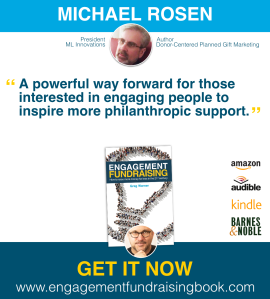Words have the power to inspire. They also have the power to alienate. Words can touch us or they can fall flat.
In my previous post, I shared seven words that, when used together, can earn you the respect, trust, and appreciation of prospects and donors.
 Mary Cahalane, of the Hands-on Fundraising blog, looked at words from a different perspective in her excellent post “7 Words and Phrases that Should Die.”
Mary Cahalane, of the Hands-on Fundraising blog, looked at words from a different perspective in her excellent post “7 Words and Phrases that Should Die.”
Inspired by Mary, I now want to share my list of planned-giving and major-giving related words and phrases that, at times, make me cringe:
Planned Giving. I know, I just used the term “planned giving,” and now I’m telling you it makes me cringe. Let me explain. The term is jargon. As such, I think it’s fine to use with other nonprofit professionals in the office. It nicely encompasses all of the various ways of planning a gift. Unfortunately, most donors have either no idea what the term means or only a vague, partial notion.
When speaking with a prospect, avoid talking about “planned giving.” Instead, talk with your prospects about their “legacy” and the specific gift structure(s) you want to suggest. For example, talk about a gift in a will or a Charitable Gift Annuity rather than using the confusing and, for the context, overly broad term “planned giving.” If you need a generic term to use with prospects, I prefer “legacy giving,” while I acknowledge that that phrase is not completely without its own problems.
Bequest. When you read the previous paragraph, you might have noticed I avoided this word. You might have guessed that I don’t particularly like the word “bequest.” If you did, you’re right.
First, many people don’t really understand what a “bequest” is. Second, many of those who do understand the word think it is something only rich folks do. Third, the word sounds funereal to some.
Instead of using the word “bequest,” talk with prospects in simple, easy to understand terms. Don’t ask them to make a charitable bequest commitment. Ask your prospects to include your organization in their will.
Philanthropy. This is a great word. It comes from a Greek word literally meaning “love of humankind.” Unfortunately, some prospects, and even some donors, find the word alienating.
I remember speaking with a woman while we were waiting in the wings at a National Philanthropy Day luncheon. I was about to present her with the Partnership for Philanthropic Planning of Greater Philadelphia Legacy Award for Planned Giving Philanthropist of the Year. She told me she was honored to be present, but she wanted me to know, “I’m not really a philanthropist.”
I explained to the award recipient what the word “philanthropy” means. And I explained that it is not a term that is exclusive to the wealthy. I made sure she understood that she is indeed a philanthropist. I’m glad I had the chance to explain “philanthropy” to this caring donor. Sadly, we don’t always have such an opportunity.
If you’re thinking about using the word “philanthropy,” know your audience and know whether the term will resonate. Just keep in mind that 70 percent of people with investible assets of $1 million or more do not consider themselves wealthy, according to The UBS Investor Watch. If your prospects think “philanthropy” is only for the wealthy, and they’re not wealthy, you’re going to have some problems if you toss around the word. Words such as “legacy” or “support” might do nicely instead.
read more »











 Donors create a DAF by opening an account with charitable organization equipped to manage it. Donors then make irrevocable donations of cash or appreciated assets to their DAF account to receive current year tax benefits and deductions. Donors can choose how their contributions are invested creating the potential for tax-free growth that can fund larger charitable grants. Donors “advise” when and how much to grant and to which organizations.
Donors create a DAF by opening an account with charitable organization equipped to manage it. Donors then make irrevocable donations of cash or appreciated assets to their DAF account to receive current year tax benefits and deductions. Donors can choose how their contributions are invested creating the potential for tax-free growth that can fund larger charitable grants. Donors “advise” when and how much to grant and to which organizations.
 When the Girl Scouts received the $100,000 gift, the staff was understandably thrilled. The money equaled approximately one-third of the organization’s financial assistance program budget for the year. The Girl Scouts offer financial assistance so that any girl can join despite economic obstacles.
When the Girl Scouts received the $100,000 gift, the staff was understandably thrilled. The money equaled approximately one-third of the organization’s financial assistance program budget for the year. The Girl Scouts offer financial assistance so that any girl can join despite economic obstacles.


